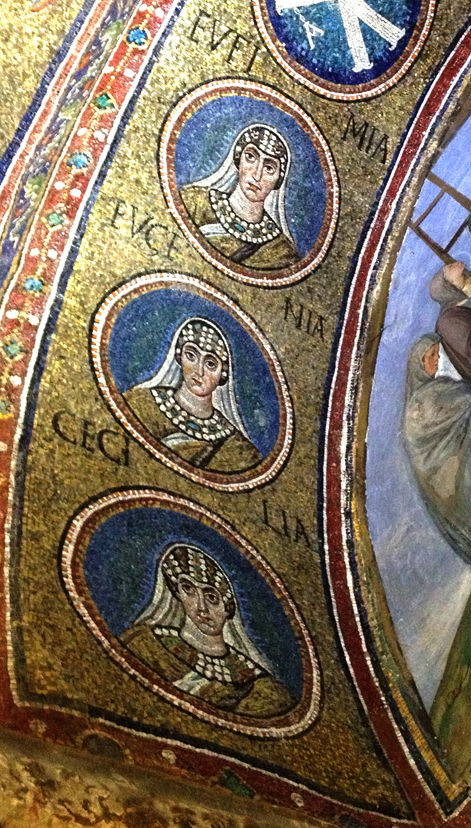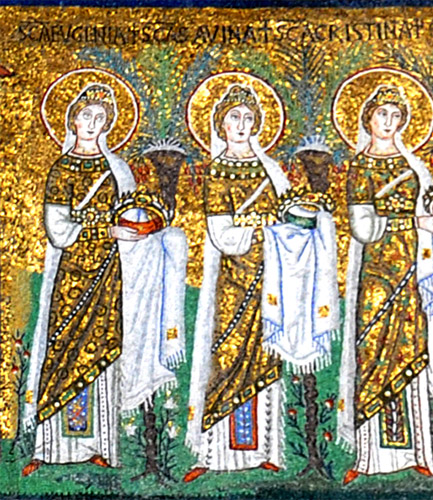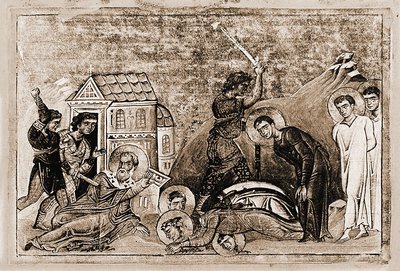But after a dispute with her father she comes upon the teachings of the Apostle Paul. Her interest deepens when she leaves Alexandria and visits the outer settlements where the Christians live. Listening to their hymns and observing the miraculous demonstrations wrought by their leaders, she gains an understanding of their faith and shares it with Protus and Hyacinthus. At last, all three are baptized and enter a monastery, Eugenia disguising herself as a man.
Some years later, as the monk "Eugenius" she is falsely charged with rape and brought before Philippus, who has thought his daughter dead. In a highly dramatic scene she proves her innocence by baring her breasts and revealing herself as Eugenia. The discovery leads to the Philippus's conversion, his eventual selection as bishop of Alexandria, and finally his martyrdom.
In the Vitae Patrum the adventures in Egypt are followed immediately by a different author's narrative of St. Eugenia's life in Rome. Having enlisted a great number of other virgins into the faith, she is brought before the co-emperors Valerian and Galienus. They order her to be tied to a great stone and cast into the Tiber. She survives, so they have her cast into a roaring fire. That failing, she is locked up in a dark cell and left to starve. But Christ brings her bread and keeps her alive, so at last the emperors have her taken from the cell and beheaded on the feast of the Nativity, December 25.4
The only narrative images I have found are the miniature at the top of this page and a triptych in Saint-Pierre de Varzy that pictures her trial and her apotheosis. The center of the miniature shows the beheading of Eugenia, Protus, and Hyacinthus. On the left Philippus is beaten and then killed with a sword. The narrative in the Vitae Patrum mentions the beatings but does not specify how Philippus was executed. The two young men on the right are Avitus and Segius, Eugenius's brothers.
The portraits of Eugenia at right do not distinguish her from the other virgins pictured. In Orthodox icons she holds a hand cross, the emblem of martyrs in that tradition.
Prepared in 2014 by Richard Stracke, Emeritus Professor of English, Augusta University, revised 2015-10-30.
HOME PAGE
11th-century manuscript illustration from the Menologion of Basil – see the description page.
OTHER IMAGES

In a 6th-century mosaic in Ravenna – See the description page

At Sant'Apollinare Nuovo, Ravenna, St. Eugenia is at the far left in the procession of virgins pictured in 6th-century mosaics along the north wall of the nave. Click here to see the entire wall and some detail photographs.
DATES
- December 25 for Roman Catholics, December 24 for Orthodox.
- Eugenia died in 256.
BIOGRAPHY
- Circa 4th-6th century: Eugenia's vita is included in the Vitae Patrum (Patrologia Latina, LXIII).
- 8th century: John of Stylite's vita, in Select Narratives, 1-35.
- 13th century: Golden Legend #136 (Protus and Hyacinth, html or pdf) is a faithful but condensed version of the vita in the Vitae Patrum.
NOTES
1 Butler, IV, 612.
2 Anonymous, Vita Sanctae Eugeniae. Migne, Pat. Lat. LXXIII, 605-20.
3 A "hagiographic romance" adapts to Christian purposes the plot devices that had characterized secular novels in classical times. The most common characteristic is a separation of a couple (two lovers, father and child, etc.) followed by marvelous adventures experienced by one or both members of the couple. The structure is episodic, the episodes tend to feature marvels that the reader would not encounter in everyday life, and at the end the couple is reunited in some surprising way. See Stouck, 517-591 and Robertson, 200-252.
4 Valerian and his son Gallienus ruled as co-emperors from 253 to 262. Critics agree that the Roman segment of the story is an addition by another writer. See Bonner, 256. It lacks the narrative sophistication of the main section, with its erudite speeches, its arc of events leading to the final
anagorisis
, and its use of point of view to pace out the unfolding of Eugenia's understanding of the Christian faith.
